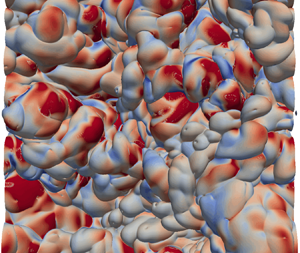Published online by Cambridge University Press: 13 December 2024

Direct numerical simulations are performed to explore the evolution behaviour of the turbulent/non-turbulent interface (TNTI) in a temporally evolving turbulent plane jet, using the evolution equation for the TNTI surface area. A novel algorithm is used to calculate the surface area of the TNTI and entrainment flux. It is shown that the surface area remains relatively constant, which leads to the mean entrainment velocity being inversely proportional to the square root of time. On average, the effects of the stretching and curvature/viscous terms on the TNTI area roughly counterbalance each other, while the curvature/inviscid term associated with vortex stretching is virtually zero. More specifically, the stretching term contributes to the production of the surface area, while the curvature/viscous term is associated with a destruction in the surface area. The local effect of the curvature/viscous term exhibits high spatial intermittency with small-scale extreme/intense events, whereas the effect of the large-scale stretching term is more continuous. To shed light on the contribution of curvature/viscous term to the evolution of the surface area, we decompose it into three components. The effect of the curvature/normal diffusion term (the curvature/viscous dissipation term) in the bulging regions (the valley regions) mainly contributes to the production of the area. The continuous decrease of the average mean curvature is associated with the production of the bulging regions and the destruction of the valley regions. Finally, although the entrainment velocity is mainly dominated by the normal diffusion effect, all three components related to the viscous effect are indispensable to the production and destruction of the TNTI area. This numerical study contributes to a better understanding of the evolution of the TNTI area.
To send this article to your Kindle, first ensure no-reply@cambridge.org is added to your Approved Personal Document E-mail List under your Personal Document Settings on the Manage Your Content and Devices page of your Amazon account. Then enter the ‘name’ part of your Kindle email address below. Find out more about sending to your Kindle. Find out more about saving to your Kindle.
Note you can select to save to either the @free.kindle.com or @kindle.com variations. ‘@free.kindle.com’ emails are free but can only be saved to your device when it is connected to wi-fi. ‘@kindle.com’ emails can be delivered even when you are not connected to wi-fi, but note that service fees apply.
Find out more about the Kindle Personal Document Service.
To save this article to your Dropbox account, please select one or more formats and confirm that you agree to abide by our usage policies. If this is the first time you used this feature, you will be asked to authorise Cambridge Core to connect with your Dropbox account. Find out more about saving content to Dropbox.
To save this article to your Google Drive account, please select one or more formats and confirm that you agree to abide by our usage policies. If this is the first time you used this feature, you will be asked to authorise Cambridge Core to connect with your Google Drive account. Find out more about saving content to Google Drive.